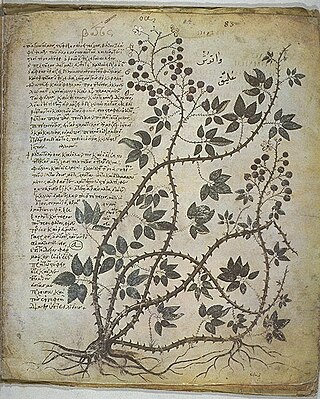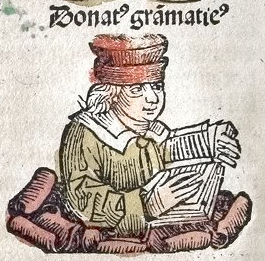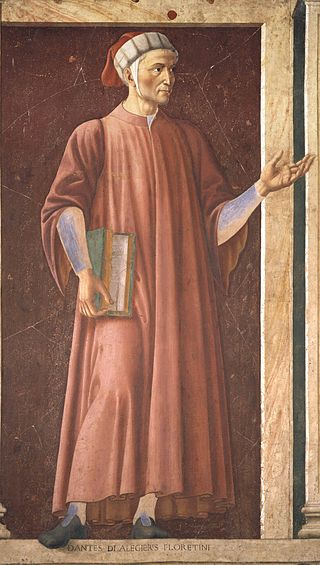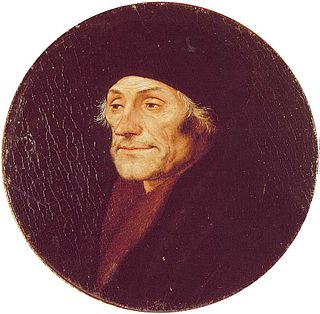Related Research Articles

Proclus Lycius, called Proclus the Successor, was a Greek Neoplatonist philosopher, one of the last major classical philosophers of late antiquity. He set forth one of the most elaborate and fully developed systems of Neoplatonism and, through later interpreters and translators, exerted an influence on Byzantine philosophy, Early Islamic philosophy, Scholastic philosophy, and German Idealism, especially G.W.F. Hegel, who called Proclus's Platonic Theology "the true turning point or transition from ancient to modern times, from ancient philosophy to Christianity."

Servius, distinguished as Servius the Grammarian, was a late fourth-century and early fifth-century grammarian. He earned a contemporary reputation as the most learned man of his generation in Italy; he authored a set of commentaries on the works of Virgil. These works, In Tria Virgilii Opera Expositio, Commentarii in Virgilium, Commentarii in Vergilii Opera, or Vergilii Carmina Commentarii, constituted the first incunable to be printed at Florence, by Bernardo Cennini, in 1471.

Pedanius Dioscorides, "the father of pharmacognosy", was a Greek physician, pharmacologist, botanist, and author of De materia medica —a 5-volume Greek encyclopedia about herbal medicine and related medicinal substances, that was widely read for more than 1,500 years. For almost two millennia Dioscorides was regarded as the most prominent writer on plants and plant drugs.

Materia medica is a Latin term from the history of pharmacy for the body of collected knowledge about the therapeutic properties of any substance used for healing. The term derives from the title of a work by the Ancient Greek physician Pedanius Dioscorides in the 1st century AD, De materia medica, 'On medical material'.
This article contains information about the literary events and publications of 1508.
Middle English Bible translations (1066-1500) covers the age of Middle English, beginning with the Norman conquest and ending about 1500.

Aelius Donatus was a Roman grammarian and teacher of rhetoric.
Themistius, nicknamed Euphrades, was a statesman, rhetorician and philosopher. He flourished in the reigns of Constantius II, Julian, Jovian, Valens, Gratian and Theodosius I, and he enjoyed the favour of all those emperors, notwithstanding their many differences and the fact that he himself was not a Christian. He was admitted to the senate by Constantius in 355, and he was prefect of Constantinople in 384 on the nomination of Theodosius. Of his many works, thirty-three orations of his have come down to us, as well as various commentaries and epitomes of the works of Aristotle.

Renaissance Latin is a name given to the distinctive form of Literary Latin style developed during the European Renaissance of the fourteenth to fifteenth centuries, particularly by the Renaissance humanism movement. This style of Latin is regarded as the first phase of the standardised and grammatically "Classical" Neo-Latin which continued through the 16th–19th centuries, and was used as the language of choice for authors discussing subjects considered sufficiently important to merit an international audience.

Arethas of Caesarea was Archbishop of Caesarea Mazaca in Cappadocia early in the 10th century, and is considered one of the most scholarly theologians of the Greek Orthodox Church. The codices produced by him, containing his commentaries are credited with preserving many ancient texts, including those of Plato and Marcus Aurelius' "Meditations".

Eustathius of Thessalonica was a Byzantine Greek scholar and Archbishop of Thessalonica and is a saint in the Eastern Orthodox Church. He is most noted for his stand against the sack of Thessalonica by the Normans in 1185, contemporary account of the event, for his orations and for his commentaries on Homer, which incorporate many remarks by much earlier researchers.
In classical scholarship, the editio princeps of a work is the first printed edition of the work, that previously had existed only in manuscripts. These had to be copied by hand in order to circulate.

Giovanni Battista Ramusio was an Italian geographer and travel writer.

Novum Instrumentum Omne, later called Novum Testamentum Omne, was a bilingual Latin-Greek New Testament with substantial scholarly annotations, and the first printed New Testament of the Greek to be published. It was prepared by Desiderius Erasmus (1466–1536) and printed by Johann Froben (1460–1527) of Basel.

Commentaries on Aristotle refers to the great mass of literature produced, especially in the ancient and medieval world, to explain and clarify the works of Aristotle. The pupils of Aristotle were the first to comment on his writings, a tradition which was continued by the Peripatetic school throughout the Hellenistic period and the Roman era. The Neoplatonists of the Late Roman Empire wrote many commentaries on Aristotle, attempting to incorporate him into their philosophy. Although Ancient Greek commentaries are considered the most useful, commentaries continued to be written by the Christian scholars of the Byzantine Empire and by the many Islamic philosophers and Western scholastics who had inherited his texts.
John of Wales, also called John Waleys and Johannes Guallensis, was a Franciscan theologian who wrote several well-received Latin works, primarily preaching aids.

James Hankins is an American intellectual historian specializing in the Italian Renaissance. He is the General Editor of the I Tatti Renaissance Library and the Associate Editor of the Catalogus Translationum et Commentariorum. He is a professor in the History Department of Harvard University. In Spring 2018, he is a Visiting Research Fellow at the University of Notre Dame Center for Ethics and Culture.

De materia medica is a pharmacopoeia of medicinal plants and the medicines that can be obtained from them. The five-volume work was written between 50 and 70 CE by Pedanius Dioscorides, a Greek physician in the Roman army. It was widely read for more than 1,500 years until supplanted by revised herbals in the Renaissance, making it one of the longest-lasting of all natural history and pharmacology books.
David Anderson is a former college professor. He was trained as a literary historian at Princeton University, where he studied with D. W. Robertson, and at universities in Italy, especially the scholarly circle around Giuseppe Billanovich at the Catholic University of Milan. It was as a visiting scholar at Milan that he completed his study of the post-classical interpretations of Statius' epic poem Thebaid and their influence on Boccaccio and Chaucer, published as Before the Knight's Tale, and identified in scattered manuscript sources a previously unrecognized commentary that was shown to be present in Boccaccio's library and used by that author in his works: "Boccaccio's Glosses on Statius," Studi sul Boccaccio (1996). At the University of Pennsylvania (1980–1988), he was the first male member of the faculty to take an extended parenting leave. At the time, the request was unusual, and his act occasioned public discussion of gender bias in employment policies and was the subject of a front-page article in the Daily Pennsylvanian, "Mr. Mom: Paternity Leave Allows English Prof to Raise Son". In 1986 he curated an exhibition and catalogue of manuscripts and early printed books illustrating Chaucer's works and their cultural influences, Sixty Books Old and New. The exhibition was held at the University of Pennsylvania and the Rosenbach Foundation and was supported by several Philadelphia-area charitable organizations, which made possible the distribution of copies of the catalogue to English teachers in the Philadelphia public school district. Anderson's other publications include Pound's Cavalcanti, which remains "invaluable" to Ezra Pound scholars.